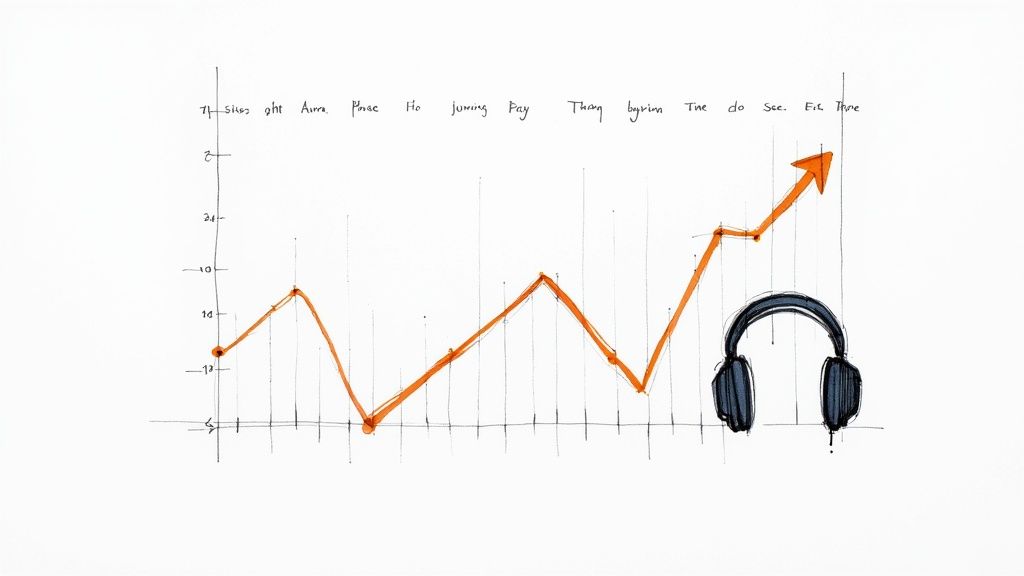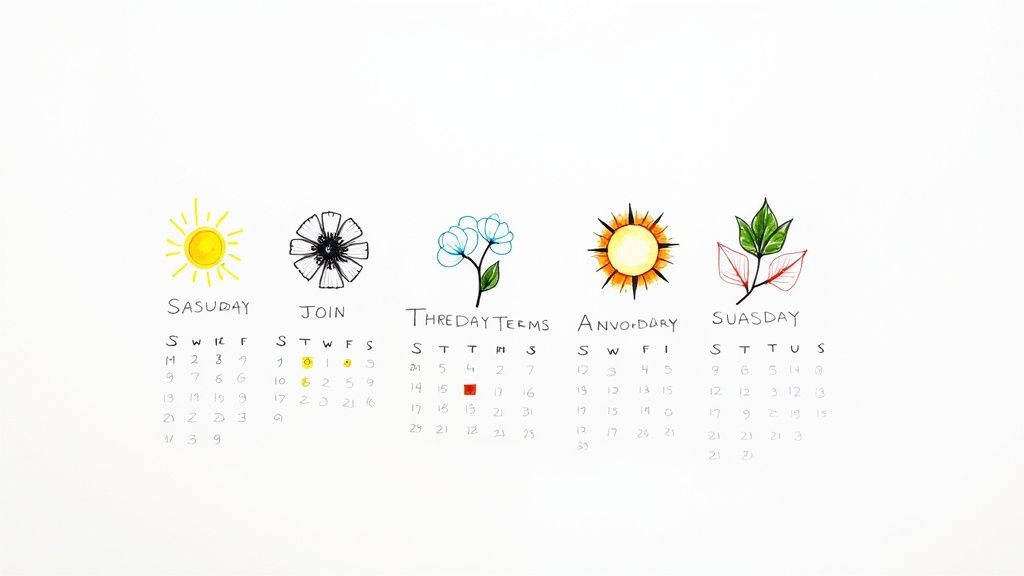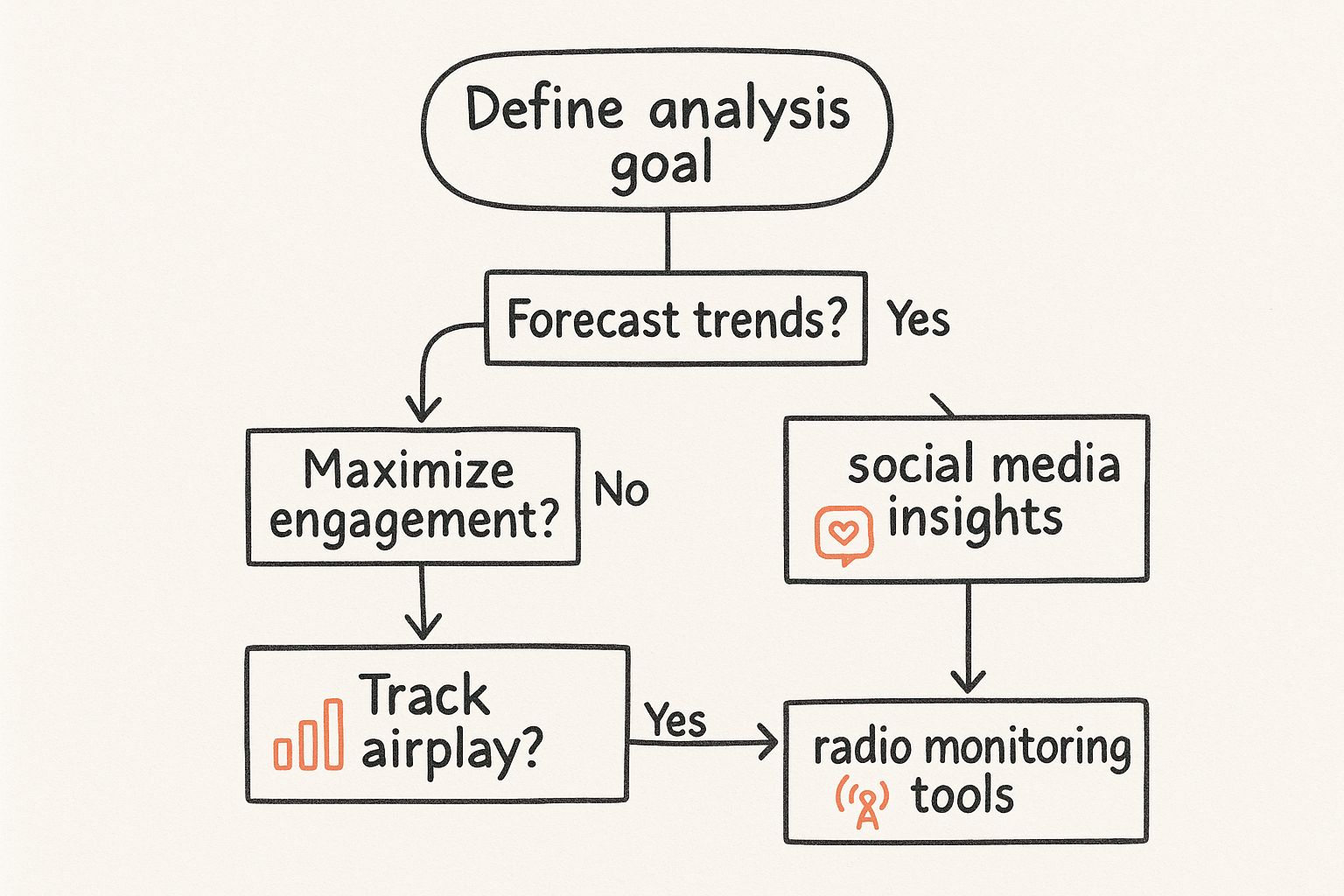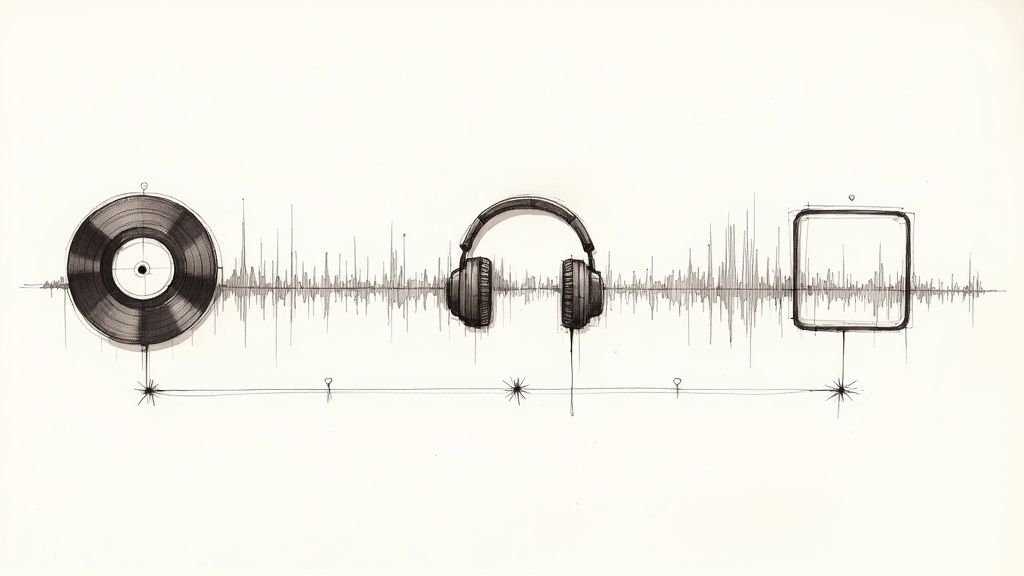Best Time to Release Music for Maximum Impact
- Tamara Bosmans
- Jul 3
- 14 min read
If you’re trying to pinpoint the single best time to release music, the industry standard is pretty clear: Friday at midnight, local time. This isn't just some old-school tradition that stuck around; it's a strategic move that lines up perfectly with the rhythm of the modern music world, especially the all-important schedules of streaming platforms.
The Friday Rule and Why It Still Matters
So, why has Friday become the undisputed champion for new music drops? The short answer is that it's all part of a coordinated global strategy to maximize impact from the very first minute a track goes live. This wasn't a random choice but a deliberate decision made to sync up the entire industry.
Think of it like the premiere of a blockbuster movie. All the hype, marketing, and fan excitement are funneled into one powerful moment. Dropping your music on a Friday means it's available worldwide for the entire weekend, right when people are most actively listening and looking for new tunes.
Aligning with Global Release Day
The modern music economy runs on streams. As streaming took over, the industry realized it needed to standardize its release schedule. This led to the creation of the Global Release Day, a unified launch day designed to fight piracy and create a consistent experience for fans everywhere.
Since late 2015, new music has been synchronized to drop on Fridays at 00:01 local time across more than 45 countries. This decision was driven by the explosion of streaming, which now accounts for the lion's share of how we all consume music. In fact, if you look at the IFPI Global Music Report 2024, you'll see that subscription streaming makes up over half of all global recorded music revenues, cementing its role as the industry's primary engine.
This coordinated effort means that when your track goes live, it's competing on the same timeline as the biggest artists in the world. You get access to the same initial 24-hour window that platforms like Spotify monitor so closely.
The New Music Friday Effect
The biggest advantage of a Friday release is its direct pipeline to Spotify's most influential editorial playlist: New Music Friday. For any artist trying to break through, this playlist is the holy grail. It's updated every single week with the freshest new tracks.
Here’s why that matters so much:
Maximum Visibility: Landing on New Music Friday puts your song in front of millions of highly engaged listeners who are actively hunting for their next favorite artist.
Algorithmic Signals: A feature here sends incredibly powerful, positive signals to Spotify's algorithm. This massively increases the chances of your track getting pushed into other algorithmic playlists like Discover Weekly and Release Radar.
First-Week Momentum: The data from that first week—every stream, save, and share—is critical. A strong Friday launch gives you a full seven days to rack up numbers before the next cycle, setting you up for sustained growth.
To keep it simple, here's a quick breakdown of the standard industry timing and the logic behind it.
Quick Guide to Standard Release Timing
This table summarizes the industry's go-to schedule and the main reasons it's become the standard. It’s the baseline that most labels and distributors work from.
Day | Time | Key Reason | Primary Goal |
|---|---|---|---|
Friday | 12:00 AM Local Time | Aligns with Global Release Day. | Maximize first-week streams. |
Friday | 12:00 AM Local Time | Syncs with editorial playlist updates. | Increase chances of landing on New Music Friday. |
Friday | 12:00 AM Local Time | Catches listeners heading into the weekend. | Drive initial engagement and social sharing. |
While this is the established norm, it's not the only strategy. As we'll explore, there are compelling reasons to break from the pack, but understanding the "why" behind the Friday rule is the essential first step.
How Streaming Algorithms Changed Everything

The leap from physical CDs to streaming wasn't just a change in format—it completely flipped the script on music discovery and what it takes to have a successful release. Back in the day, success was all about manufacturing timelines, shipping logistics, and fighting for prime shelf space at Tower Records. Today, the entire game is played on a digital field, and the rules are set by powerful platform algorithms.
This shift has been a game-changer for independent artists. Services like DistroKid and TuneCore have kicked down the old industry gates, giving any musician a direct line to a global audience. But with this newfound access comes a new challenge: you have to learn how to work with the very systems that get your music heard.
The best time to release music isn't about when people might be browsing a record store anymore. It's about feeding the data-hungry algorithms on platforms like Spotify and Apple Music at the exact moment they'll pay the most attention.
These platforms are always watching and learning. They track every single play, skip, save, and playlist add to figure out which songs are hitting the mark with listeners. Your release timing is your first, and arguably best, shot at making a strong first impression on this system.
The Power of First-Day Data
Think of your track's release day like the first day of school. The algorithm is the teacher, keeping a close eye on all the new kids to see who's making friends and getting positive reactions. The more buzz your song generates in its first 24-48 hours, the more the algorithm "believes" it's a quality track that deserves to be introduced to new listeners.
This initial burst of activity sends some incredibly strong signals. It tells Spotify things like:
High Listener Interest: People are actively looking for your song and hitting play.
Strong Audience Connection: Listeners aren't just streaming; they're saving the track to their personal libraries and adding it to their own playlists.
Low Skip Rate: People are listening all the way through, which tells the algorithm they're genuinely enjoying it.
This first-day data is precisely why a well-coordinated release plan is so vital. All the pre-release hype you build on social media and with your fans needs to funnel directly into driving streams the second your song goes live. This is how you create the critical momentum the algorithm needs to pick up your track and share it far beyond your existing fanbase.
This digital-first mindset is at the heart of a massive industry transformation. The entire music production and distribution market is projected to more than double, rocketing from $41.46 billion to $96 billion by 2034, driven by a steady 8.7% annual growth rate. This boom is happening because platforms allow for instant, global digital drops, making smart timing more critical than ever. You can dig deeper into this market shift on Fact.MR. This explosive growth is all the proof you need that success now hinges on immediate, efficient digital access.
Cracking the Spotify Playlist Code

Landing a track on a major Spotify editorial playlist can feel like winning the lottery, but it's far from a game of chance. It's a strategic process, and getting it right can put your music in front of millions of new listeners practically overnight.
The key to unlocking this massive opportunity is right inside your Spotify for Artists dashboard. You just have to know how to use it.
Your Direct Line to Spotify Editors
Think of Spotify's editorial team as the gatekeepers to some of the most valuable real estate in the music world. To get their attention, you have to formally introduce your new music before it comes out. You wouldn’t just show up to a job interview without an appointment, right? The same logic applies here. Giving the editors enough time to actually listen is the single most important step.
The Spotify for Artists submission tool is your direct connection to the platform's human curators. When you pitch your track, you're doing more than just uploading an audio file. You’re giving them all the context they need to understand your sound—tagging its genre, mood, instrumentation, and even writing a personal pitch to explain what makes it special.
This context is everything. A well-crafted pitch can be the difference between a quick listen and a hard pass.
Submitting your music is more than a formality; it's your official application for playlist consideration. Data shows that artists who pitch their music through the tool at least seven days before release are significantly more likely to get playlisted.
The Importance of a Long Lead Time
While seven days is the absolute minimum, the most successful artists I know give themselves a much longer runway. If you really want to maximize your chances, you should be pitching your track at least three to four weeks before your release date.
Here’s why that extra time is a game-changer:
You Avoid the Rush: Spotify's editors are flooded with thousands of submissions every single day. Pitching early means your track isn't getting lost in the last-minute chaos right before New Music Friday.
It Allows for a Proper Review: A longer lead time gives editors the space to actually live with your song. They can listen multiple times and think about where it might fit across different playlists, not just the obvious ones.
It Shows You're a Pro: An early, well-prepared submission signals that you're a serious artist with a real plan. It's a small detail that makes a big impression.
This kind of advance planning has a direct line to your bank account. More playlist placements mean more streams, and more streams mean more revenue. If you're building a career, you need to know how those streams translate to cash. For a detailed breakdown, a Spotify royalties calculator can help you project what you might earn from different streaming milestones.
Ultimately, cracking the playlist code is all about giving your music the best possible shot at being heard. And it all starts with a smart, strategic, and timely pitch.
Thinking Beyond the Friday Release Rush
Everyone knows Friday is the big day for new music. It's the industry standard, but let's be honest—it's also a madhouse. Picture a six-lane highway at 5 PM on a holiday weekend. That's Friday on Spotify. Every lane is jammed with new releases from global superstars down to brand new artists, all fighting for the same sliver of attention. If you're an independent artist, is diving headfirst into that traffic jam really your best move?
This is where a little strategic thinking can make all the difference. Finding the best time to release music for you might mean skipping the highway altogether and taking a quieter, more scenic route. This is exactly why a mid-week release, maybe on a Tuesday or Wednesday, can be a game-changer.
The idea here is to build a "slow burn" instead of aiming for a loud, one-day explosion.
Releasing mid-week gives your music space to breathe. It’s your chance to pop up on the radar of bloggers, journalists, and independent playlist curators before they get completely swamped by the mountain of new tracks that hits their inbox every Friday.
Gaining an Edge With a Mid-Week Drop
When you drop a track on a Tuesday, you're not just another song in the deluge—you’re the fresh, interesting story of the day. Music journalists are always hungry for content, and your mid-week release can easily become their next headline. This lets you build a real narrative around your track, generating press and chatter that crests just as casual listeners start looking for new music for their weekend.
Here’s a quick look at how this strategy can play out for you:
Capture Early Attention: You get a 48-hour head start on the Friday crowd. This gives tastemakers and reviewers actual time to listen, process, and write about your track without being rushed.
Build Pre-Weekend Buzz: The positive press and social media mentions you collect on Tuesday and Wednesday act as a powerful launchpad, propelling your track into the weekend with momentum.
Stand Out from the Noise: Instead of being one of thousands of songs dropping on Friday, you become one of a select few making waves mid-week. It’s a totally different ballgame.
Your release day really comes down to your primary goal. This decision tree breaks down how your main objective should shape your entire approach.

The takeaway is simple: different goals require different strategies. If you want to blow up on social media, you’ll be looking at different data than if you're chasing radio airplay. Getting specific is key to a smart release.
Pros and Cons of Different Release Days
To really make the right call, it helps to lay everything out on the table. Weighing the pros and cons of each release day can clarify which path aligns best with your specific situation. A Friday drop is a direct shot at immediate playlist impact, while a Tuesday release is more about building a story through press.
Release Day | Primary Advantage | Primary Disadvantage | Best For |
|---|---|---|---|
Friday | Aligns with major editorial playlist updates (like New Music Friday). | Extremely high competition from major labels and established artists. | Artists with a large existing following or significant label/PR support. |
Tuesday/Wednesday | Less competition, more "breathing room" for press and curator discovery. | Misses the initial wave of Friday-focused listener discovery habits. | Independent artists focused on building a narrative and gaining early traction with media. |
Monday/Thursday | Can catch listeners and industry professionals at the start or end of the work week. | Less conventional, may not fit established listening or curatorial patterns. | Artists experimenting with non-traditional rollouts or targeting niche audiences. |
Neither approach is universally "better" than the other. It's all about which strategy plays to your strengths and resources as an artist. Sometimes, choosing the less crowded day is the most powerful move you can make, carving out your own space and ensuring your music gets the thoughtful listen it deserves.
Aligning Your Music with the Calendar

Finding the best time to release music is about so much more than just picking a day of the week. The smartest artists zoom out and look at the entire calendar year, aligning their music with the natural rhythm of the seasons. Why? Because listener moods and habits shift dramatically throughout the year, creating perfect windows for your music to connect on a much deeper level.
Let's use a simple analogy. You wouldn't try to sell heavy winter coats in July, right? The same logic applies to music. Dropping a sun-drenched, feel-good pop anthem in the dead of winter just feels… off. But release that same song in late May? Now you’re a serious contender for the "song of the summer."
This is what we mean by seasonal awareness. It's your secret weapon. You’re not just dropping a song; you're providing the perfect soundtrack for a specific moment in people's lives.
Navigating the Music Industry Calendar
The music industry has its own calendar, complete with predictable peaks and valleys. If you understand this flow, you can sidestep the noisiest, most competitive periods and find the quiet spots where your music actually has a chance to be heard. The biggest obstacle for any indie artist is the fourth quarter (Q4).
From mid-November through December, the music world is completely dominated by two things: holiday music and blockbuster albums from superstars. Releasing a non-holiday track during this time is like trying to whisper during a rock concert—you’re almost guaranteed to get drowned out.
For independent artists, the real opportunity is often where the major labels are quiet.
January & February: After the Q4 frenzy, the majors tend to slow down. This creates a vacuum you can fill, especially with energetic or motivational tracks that tap into that "new year, new me" vibe.
Late Summer (August & September): As the summer anthem season fades and before the Q4 chaos kicks off, there's another sweet spot. People are back from vacation, settling into new routines, and often looking for more introspective or moody tracks to usher in the fall.
Finding Your Perfect Launch Window
Choosing your release window is a balancing act between thematic fit and strategic timing. A laid-back, acoustic song can perfectly capture the cozy autumn vibe in October. A high-energy dance track dropped in late spring can ride the wave of excitement for festival season. Each season brings a different energy, and aligning your music with it makes your entire marketing push feel more natural and effective.
This strategic thinking even extends to playlisting. You can seriously improve your odds by knowing which playlists pop up in search results during different times of the year. When you master Spotify playlist SEO, you gain another layer of control, helping you target the right curators and listeners with surgical precision. By reading the calendar like a map, you can pinpoint the exact launch window that gives your unique sound the best possible chance to find its audience and shine.
Building Your Pre-Launch Campaign
Ever seen a movie premiere in an empty theater? That's what happens when you drop a great song without a plan. The real magic of a successful release happens before it ever goes live, built on a solid foundation of smart planning and genuine excitement. This is your promotional runway—the time you use to turn strangers into fans who are ready to smash the play button the second your track is out.
The trick is to think in reverse. Start with your release date and work backward from there. What absolutely needs to get done four weeks out? How about six? This simple shift in thinking helps you map out all the essential steps and avoid that last-minute scramble.
Your Pre-Release Checklist
Having a structured timeline isn't about being rigid; it's about building momentum that feels natural and powerful. Here’s a simple, battle-tested framework to get you started, kicking off at least six weeks before your song drops.
6-8 Weeks Out: Get Your Assets Locked In * Finalize the Master: Your track needs to be 100% done—mixed, mastered, and sounding incredible. This is the final audio file you'll be sending out into the world. * Create Your Artwork: Design a killer cover that not only looks good on Spotify but also captures the heart of the song.
4-6 Weeks Out: Distribute and Pitch * Submit to Your Distributor: Get your mastered track and artwork uploaded to a service like TuneCore or DistroKid. You absolutely want to do this at least four weeks in advance. It gives you a much-needed buffer in case there are any hiccups in their system. * Pitch to Spotify Editors: The moment your distributor confirms your track is in the system, head over to your Spotify for Artists dashboard and pitch it. Giving editors a 2-4 week heads-up massively improves your odds of getting noticed for their playlists.
Building a huge wave of support for release day is all about anticipation. Tools like Spotify Pre-Saves are your best friend here. They automatically add your new song to a fan’s library the day it comes out, which gives you a burst of first-day streams that the algorithm absolutely loves.
And don't forget, your release timing is just one piece of the puzzle. Knowing the [best times to post on social media](https://postonce.to/blog/best-time-to-post-on-social-media) is just as critical for all your promotional content. Every teaser, every behind-the-scenes look, every announcement needs to be timed to hit your audience when they're actually online and paying attention.
Your pre-launch campaign is the engine that drives a powerful release. If you want to go deeper and build out a truly bulletproof plan, check out these essential music business marketing tips and proven strategies to succeed.
Frequently Asked Questions About Music Releases
Still wrestling with the details of your release plan? Let's clear up some of the most common questions artists have when figuring out the best time to drop new music.
Does the Time of Day I Release My Music Really Matter?
Yes, it absolutely does. There's an industry-wide standard for a reason: 12:01 AM local time on your release day. Dropping your song at this exact moment means it goes live as soon as the new day ticks over in every time zone.
This timing is critical because it gives your song the maximum eligibility window for weekly discovery playlists like 'New Music Friday'. Just as important, it gives you a full 24 hours to rack up those crucial first-day streams, which is a major signal to Spotify's algorithm.
How Far in Advance Should I Submit to Distributors?
You'll want to get your music to your distributor (like DistroKid or TuneCore) at least four to six weeks before your release date. Trust me, you need this buffer.
First, it helps you sidestep any last-minute technical glitches that could derail your launch.
Second, it ensures your track gets delivered to every streaming platform with plenty of time to spare.
When it comes to pitching for Spotify playlists, you have to submit through your Spotify for Artists dashboard at least seven days before release. But the real sweet spot—the one that gets editors to actually pay attention—is two to four weeks in advance.
Giving curators this much lead time allows them to genuinely listen to and consider your track. It also signals that you’re a professional who plans ahead, which goes a long way.
Is It Better to Release a Single or an Album First?
For almost every emerging artist, releasing a consistent stream of singles is the way to go. Think of each single as a new "at-bat"—it's a fresh opportunity to pitch to playlists, create content for social media, and get your audience excited all over again.
This approach lets you build momentum, figure out what your listeners actually connect with, and grow your fanbase step by step. It's a much smarter way to build a foundation before you pour all the time, energy, and money into a full album or EP.
Ready to put these strategies into practice? artist.tools gives you the data you need to find the right playlist curators, track your stream growth, and build a release strategy that actually works. Start making data-driven decisions for your music today.